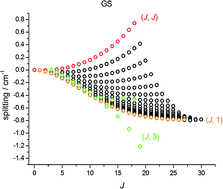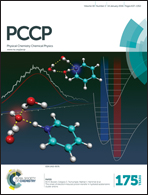Promoting and inhibiting tunneling via nuclear motions†
Abstract
Accurate, experimental rotational–vibrational energy levels determined via the MARVEL (Measured Active Rotational–Vibrational Energy Levels) algorithm and published recently for the symmetric-top 14NH3 molecule in J. Quant. Spectrosc. Radiat. Transfer, 2015, 116, 117–130 are analyzed to unravel the promoting and inhibiting effects of vibrations and rotations on the tunneling splittings of the corresponding symmetric (s) and antisymmetric (a) rovibrational energy level pairs. The experimental transition data useful from the point of view of the present analysis cover the range 0.7–7000 cm−1, sufficiently detailed rovibrational energy sets worth analyzing are available for 20 vibrational bands. The highest J value, where J stands for the rotational quantum number, within the experimental dataset employed is 30. Coupling of the “umbrella” motion of 14NH3 with other vibrational degrees of freedom has only a minor effect on the a–s tunneling splitting characterizing the ground vibrational state, 0.79436(70) cm−1. In the majority of the cases rotation around the C3 axis increases, while rotation around the two perpendicular axes decreases the tunneling splittings. For example, for the pair of vibrational ground states, 0+ and 0−, the tunneling splitting basically disappears at around J = 25 for the (J,K) = (J,1) states, where K = |k| is the usual quantum number characterizing the projection of the rotational angular momentum on the principal axis. The tunneling splittings, defined as energy differences E(a) − E(s) of corresponding energy level pairs, as a function of J and K show a very regular behavior for the ground state (GS) and the nν2 bands. For the other bands investigated exceptions from a regular behavior do occur, especially for bands characterized by degenerate vibrations, and occasionally the data available are not sufficient to arrive at definitive conclusions. The most irregular behavior is observed for rotational states characterized by the k − l = 3n rule (l is the vibrational angular momentum quantum number), with n = 0, 1, 2,… High-quality, variationally computed rovibrational data support all the conclusions of this study based on experimental energy levels.


 Please wait while we load your content...
Please wait while we load your content...